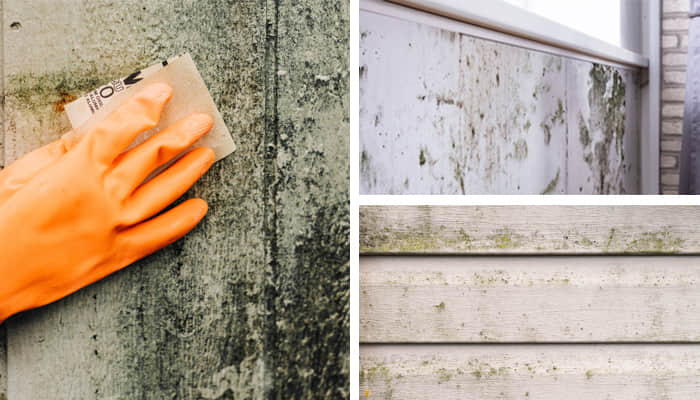Simple Steps To Clean Mold Off From Wood
Does your home get mold? We’ll show you how to easily and quickly remove it.

Wood is like a cozy spot for mold to hang out. Mold can be a real headache, turning grout lines in the shower dark, causing dry walls to change color, showing up as pesky black spots on wall panels, making decks look gloomy, and thriving on damp wood all around.
To make matters worse, it can be detrimental to you and your family’s health as well.
Mold releases tiny spores that trigger allergy reactions, runny noses, sneezing, and even irritating or harmful odors leading to respiratory issues. Wondering how to remove mold from wood? Keep reading to learn some easy, quick and effective steps to help kill mold for good.
STEP 1: Preparation Before You Begin Remove Mold

Although it’s crucial to get rid of mold in your home as soon as possible, tackling it yourself might up the chances of bumping into those pesky mold spores floating around. Inhaling or touching mold can seriously mess with your health.
To make sure you stay safe while kicking mold out of your wood, gear up with the right protective gear. Pop on some safety clothes and equipment before diving into mold-busting action. Also, make sure the spot you’re working in gets some fresh air – spin that fan to keep those spores at bay.
- Find the Source: Figure out where the mold is coming from – like leaky pipes, water damage, or just too much humidity. Fix and tackle the root cause to stop mold from popping up in the future.
- Suit Up for Safety: Get yourself geared up with the must-haves – gloves, goggles, a face mask, or an N-95 or P-100 respirator. This keeps mold spores from touching your skin or, even worse, getting into your lungs. And if you’re going bleach-crazy, throw on a protective coat too to keep your clothes safe from the bleach splatter.
- Take the Cleanup Outdoors: When dealing with moldy wooden furniture, it’s best to take the cleaning party outdoors. You’ll have plenty of space to work comfortably. Fresh air and some extra ventilation help kick those mold spores to the curb and reduce health risks.
STEP 2: Vacuum the Mold from the Wood Surface

It’s recommended to remove as many mold spores as possible using a vacuum packing a HEPA filter.
HEPA filters excel at filtering out particles, catching up to 99.97% of tiny stuff as small as 0.3 microns. This way, they make sure those sneaky mold spores stay trapped inside the vacuum and don’t sneak back into your space.
Once you’ve done the deed, don’t just throw the bag or canister in the trash inside. Take it outdoors instead, pour the vacuum bag or canister into a plastic bag outside. Seal that bag up tight and toss it away.
STEP 3: Scrub Away Mold with Soap, Water, and Vinegar

If your wood has a coat of paint or stain, that means the mold hasn’t penetrated yet. So, you can tackle the mold using a simple mix of mild cleaning solution – a combo of dish soap and warm water. Dip a soft-bristle brush into the soapy water mix and gently scrub the moldy areas in circular motions.
If the mold is still holding its ground, it’s vinegar time! Vinegar is a champ at killing over 80% of mold. Mix equal parts vinegar and warm water, spray it on the mold, and let the vinegar work its magic for an hour. Wipe the wood clean with a fresh damp cloth. Check for any lingering mold, and if there’s none, give the wood a final wipe.
STEP 4: Apply a Bleach Solution

If mold has made its way into the wood, you’ll need a solution that goes deep to knock out those stubborn spores. Bleach is the heavy hitter here, and it’s super simple too. Here’s the rundown:
Mix one part bleach, two parts water, and a dash of dish soap. Spread this solution over the moldy area on the wood. Use a soft-bristle brush to gently scrub the mold and mildew away in circular motions. Once the mold has taken a hit, rinse the wood surface with clean water and let it air dry. Give it a final polish with a soft cloth. This solution also works for unsealed wood areas.
But here’s the heads up – don’t mix chlorine bleach with anything containing ammonia or vinegar. That combo can create harmful fumes.
STEP 5: Sand the Area If Mold Remains

If those stubborn mold stains are playing hard to get, it’s time to bring in the sandpaper and give the wood surface a good sanding to remove those deeply embedded mold spores.
Gently sand the affected area until you can’t spot any trace of mold. After sanding, it’s a smart move to give the wood a touch-up or seal it. This isn’t just for the looks but also to prevent any future mold flare-ups. If you’re not a pro at sanding or fixing up wood, swing by your local home improvement store and ask about the sandpaper grit that suits your situation.
And that’s the drill on how to remove mold from wood – sand it down if the mold isn’t backing down.
